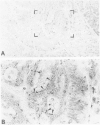Abstract
The monoclonal islet cell antibody HISL-19 was generated after immunization of BALB/c mice with human islet cell preparations. Besides reactivity with all cells of the human pancreatic islet, MAb HISL-19 also reacted with other cells of the diffuse neuroendocrine system, including anterior pituitary cells, C cells of the thyroid, endocrine cells of the gut and bronchus, the adrenal medulla, and central and peripheral neurons. In this study the authors screened a series of 53 neuroendocrine and 71 nonneuroendocrine tumors for their reactivity with MAb HISL-19 using an indirect immunoperoxidase technique on formalin-fixed and Paraplast-embedded sections. MAb HISL-19 reacted strongly with all insulomas (10), carcinoids (8), C-cell carcinomas of the thyroid (8), pituitary adenomas (6), neuroendocrine carcinomas of the skin (4), paragangliomas of the carotid body (3), and pheochromocytomas (2) tested. Neuroblastomas (3), oat-cell carcinomas of the lung (2), and melanomas (4) exhibited only very few immunoreactive cells scattered throughout the tumor or remained unstained with MAb HISL-19. With the exception of one lobular carcinoma of the breast (1/3), one adenocarcinoma of the endometrium (1/4), and one adenocarcinoma of the stomach (1/6), nonneuroendocrine tumors were negative with MAb HISL-19. Biochemical findings obtained by SDS-PAGE, "Western" immunoblotting, immunoaffinity chromatography, and absorption experiments indicate that the MAb HISL-19-defined antigen is not related to neuron specific enolase. Because the epitope recognized by MAb HISL-19 is well preserved in formalin-fixed and routinely processed tissues, this monoclonal antibody finds potential applications in diagnostic pathology as an indicator for neuroendocrine cells and their neoplasms.
Full text
PDF








Images in this article
Selected References
These references are in PubMed. This may not be the complete list of references from this article.
- Blaschko H., Comline R. S., Schneider F. H., Silver M., Smith A. D. Secretion of a chromaffin granule protein, chromogranin, from the adrenal gland after splanchnic stimulation. Nature. 1967 Jul 1;215(5096):58–59. doi: 10.1038/215058a0. [DOI] [PubMed] [Google Scholar]
- Caillaud J. M., Benjelloun S., Bosq J., Braham K., Lipinski M. HNK-1-defined antigen detected in paraffin-embedded neuroectoderm tumors and those derived from cells of the amine precursor uptake and decarboxylation system. Cancer Res. 1984 Oct;44(10):4432–4439. [PubMed] [Google Scholar]
- Carlei F., Polak J. M. Antibodies to neuron-specific enolase for the delineation of the entire diffuse neuroendocrine system in health and disease. Semin Diagn Pathol. 1984 Feb;1(1):59–70. [PubMed] [Google Scholar]
- Eisenbarth G. S., Shimizu K., Bowring M. A., Wells S. Expression of receptors for tetanus toxin and monoclonal antibody A2B5 by pancreatic islet cells. Proc Natl Acad Sci U S A. 1982 Aug;79(16):5066–5070. doi: 10.1073/pnas.79.16.5066. [DOI] [PMC free article] [PubMed] [Google Scholar]
- Haimoto H., Takahashi Y., Koshikawa T., Nagura H., Kato K. Immunohistochemical localization of gamma-enolase in normal human tissues other than nervous and neuroendocrine tissues. Lab Invest. 1985 Mar;52(3):257–263. [PubMed] [Google Scholar]
- Köhler G., Milstein C. Continuous cultures of fused cells secreting antibody of predefined specificity. Nature. 1975 Aug 7;256(5517):495–497. doi: 10.1038/256495a0. [DOI] [PubMed] [Google Scholar]
- O'Connor D. T., Burton D., Deftos L. J. Chromogranin A: immunohistology reveals its universal occurrence in normal polypeptide hormone producing endocrine glands. Life Sci. 1983 Oct 24;33(17):1657–1663. doi: 10.1016/0024-3205(83)90721-x. [DOI] [PubMed] [Google Scholar]
- Pearse A. G., Takor T. Embryology of the diffuse neuroendocrine system and its relationship to the common peptides. Fed Proc. 1979 Aug;38(9):2288–2294. [PubMed] [Google Scholar]
- Pearse A. G. The cytochemistry and ultrastructure of polypeptide hormone-producing cells of the APUD series and the embryologic, physiologic and pathologic implications of the concept. J Histochem Cytochem. 1969 May;17(5):303–313. doi: 10.1177/17.5.303. [DOI] [PubMed] [Google Scholar]
- Polak J. M., Bloom S. R. The diffuse neuroendocrine system. Studies of this newly discovered controlling system in health and disease. J Histochem Cytochem. 1979 Oct;27(10):1398–1400. doi: 10.1177/27.10.512327. [DOI] [PubMed] [Google Scholar]
- Scearce R. M., Eisenbarth G. S. Production of monoclonal antibodies reacting with the cytoplasm and surface of differentiated cells. Methods Enzymol. 1983;103:459–469. doi: 10.1016/s0076-6879(83)03032-3. [DOI] [PubMed] [Google Scholar]
- Schmechel D., Marangos P. J., Brightman M. Neurone-specific enolase is a molecular marker for peripheral and central neuroendocrine cells. Nature. 1978 Dec 21;276(5690):834–836. doi: 10.1038/276834a0. [DOI] [PubMed] [Google Scholar]
- Towbin H., Staehelin T., Gordon J. Electrophoretic transfer of proteins from polyacrylamide gels to nitrocellulose sheets: procedure and some applications. Proc Natl Acad Sci U S A. 1979 Sep;76(9):4350–4354. doi: 10.1073/pnas.76.9.4350. [DOI] [PMC free article] [PubMed] [Google Scholar]
- Wilson B. S., Lloyd R. V. Detection of chromogranin in neuroendocrine cells with a monoclonal antibody. Am J Pathol. 1984 Jun;115(3):458–468. [PMC free article] [PubMed] [Google Scholar]






